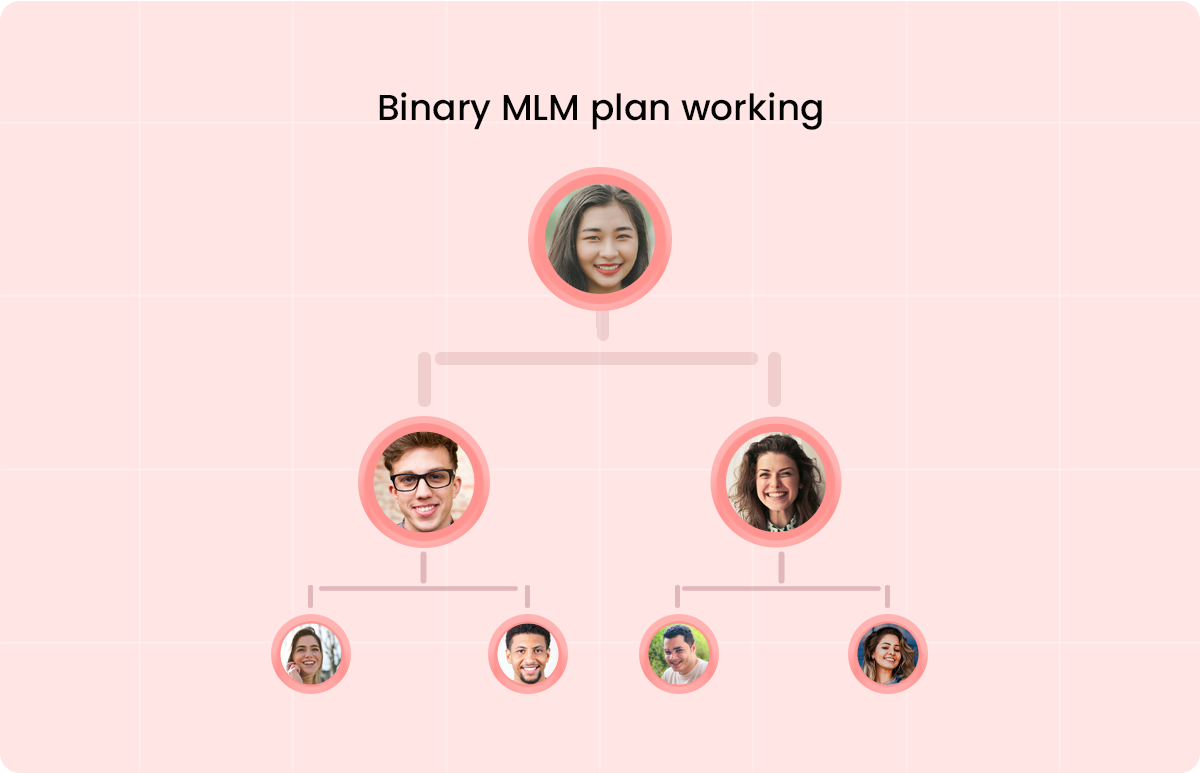When you start looking at multi-level marketing opportunities, one thing you will realize is that there are plenty of options available around, especially with MLM plans. It all boils down to your business objectives and goals that determine which plan to go with.
Two of the main options available out there are binary and Hybrid. You will find a lot of companies using varieties of these two plans in their business models. Our aim here today is to help you understand how these plans work and which one will suit your business better, especially if you are an entrepreneur who is looking for options.
Binary MLM plan

With the binary MLM plan, the members you bring in get added to your left side or right side, and it grows like that. This plan rewards you on the basis of the performance of your weaker branch (or leg, as we have it in MLM lingo), so that automatically gives you motivation to work towards balancing both the legs. It is straightforward like that. All you have to concentrate on is ensuring both of these branches grow evenly for a steadily growing income.
Hybrid MLM plan
Hybrid will help you get the best of two different MLM plans. For example,you can combine the binary MLM plan, which has two branches, with a plan that can accommodate unlimited levels of members. This comes with a lot of benefits since you are getting rewarded in different ways from different parts of this hybrid plan.
For people who are starting a new business, this is super useful. When you have many people joining your business in the beginning, you can use a part of this plan and afterward, when you prefer balanced growth, the other part will come in handy.
It can sound a bit complex, but it allows you to be creative with your MLM business; this plan is a blessing.
This understanding will help you get through the following part of this article, where we compare various aspects of these plans. This will help you make a fair judgment and choice for your MLM business.
Binary MLM plan vs Hybrid MLM plan
| Criteria | Binary Plan | Hybrid Plan |
|---|---|---|
| Structure | A simple two-leg model where one is placed in either the left leg or the right leg. The two must eventually be in balance with each other. | A flexible structure combining two or more MLM plans. This may have more than one compensation plan and also multiple earning paths. |
| Ease of Implementation | This is easier to implement because of its simple structure but still requires tracking tools to manage downlines. | It is more complicated to set up because of merging various plans, and therefore it requires more advanced management and software systems. |
| Payout Structure | Focus is on weaker leg’s performance, encouraging balanced growth. Payout is based on weaker leg sales volume. | Varies depending on the combination of plans. Includes direct bonuses, matching bonuses, team commissions, etc. |
| Initial Investment | Demands investment in training for balanced growth and software for tracking incentives and sales. | Higher costs due to the need for advanced management software and more training for the complex plan setup. |
| Scalability | Limited by the need for balanced growth between legs. Spillover can help at times but requires careful planning. | More scalable as the flexibility allows adjusting plans for optimal growth based on business needs. |
| Risk Management | Risk of "flushing" commissions if one leg outpaces the other, leading to potential lost commissions. | More flexible, reducing risk by offering multiple criteria for bonuses and payouts, balancing weaker parts. |
| Recruitment Flexibility | Requires strategic placement of new members to maintain balance between legs, which can be challenging. | Offers more freedom in recruitment and placement and thereby allows organic growth and multiple income streams. |
| Maintenance Costs | Ongoing costs for software and tools to manage balanced growth and scalability. | Higher maintenance costs due to the complexity of managing multiple compensation plans and the need for customization. |
| Growth Potential | Growth depends on maintaining balance between the two legs, which can limit quick expansion. | Offers greater long-term growth potential by allowing adjustment based on business demands and external market factors. |
Structure
The binary plan is very convenient because it is a clear two-branch model. Here, the branches grow vertically and go into deep levels. It looks just like a tree that has two main branches growing downward. It comes with the advantage of spillover, where your upline sponsors might place a few of their members on your downline. It helps you with growth a bit, but again, maintaining the balance between your downline is still your part.
The hybrid plan is flexible with its structure depending on the plans you are combining together. Your members will be placed according to the combination of MLM plans you use. This plan is designed with the aim of helping you take advantage of different compensation methods. You can earn in multiple ways—be it from direct recruits, team bonuses or matching bonuses.
Ease of implementation
This should be an important consideration when you start out, for your peace of mind.
The binary plan is relatively simple to use due to its straightforward structure, with just left and right legs. But even then, it comes with a fair share of responsibilities. You might need a proper downline tracking software that can help you handle your downlines.
On the other side, the hybrid plan isn't very direct. Because it combines two or more plans, it might seem challenging to set it up in the beginning. The implementation part might demand the management of both vertical and horizontal growth, which can be overwhelming at times. But over time, these efforts can really pay off.
Payout Structure
The payout structure on the binary MLM plan focuses on the growth of the weaker leg. Since payouts are calculated on the basis of the sales volume your weaker leg generates, it becomes a gentle push to grow both legs in a balanced way.
For the hybrid plan, this can differ based on the plans you put together. Depending on that, your members can have different choices, like direct bonuses, matching bonuses, team commissions and more. Your payout system becomes versatile with this.
Initial investment
The binary plan costs you majorly for one thing—maintaining balanced growth. This means you will have to spend on training to make your members aware of the importance of having balanced growth and the ways to achieve that. Along with this, you might have to invest in a good MLM software platform that will help you track the incentives and sales.
Things get a bit more expensive with the hybrid plan. Having multiple compensation plans in the system will require more sophisticated management, mostly using software. Also, it is a bit harder to comprehend for people, meaning more time on training. These little investments can add up to a considerable amount of money.
Discover how we build resilient businesses with advanced MLM functionalities
Scalability
When we take scalability into consideration, one thing that limits the binary plan is the requirement for having a balanced growth. The growing leg has to wait until the weaker one catches up and that can hinder the growth. Although we have spillover that can help with the growth of weaker legs, efforts have to be put into planning it efficiently for a consistent growth.
But that's not the case with the hybrid MLM plan. Since it is a combination of different MLM plans, we have the freedom to choose the suitable plans for optimal scalability. When you think your business needs a different treatment, you can freely choose a combination that can accommodate these changes.
Risk Management
The risky part with the binary plan, as we had already mentioned, is the need to have a balanced growth. This means, if one leg grows faster than the other one, then it makes the latter weak. Then it causes loss of commissions from the stronger leg, known as 'flushing'. This can put a pressure to have a uniform growth that might lead to poor placement of members in the downline.
This risk is mitigated with the hybrid plan because even if you have one part of your plan underperforming, the other one can make up for it. When the binary plan wants you to have a balanced growth, hybrid can adopt a mix of criteria for bonuses and payouts. This easily spreads the risk out evenly.
Recruitment Flexibility
With the binary plan, you should be strategically placing the new members joining the team. You have to carefully plan the placements since there is a constraint on weaker leg's performance. To be successful with this effort, your teams have to work closely and manage the downline placement, which can be challenging at times.
The hybrid plan doesn't have such restrictions so that allows you to have flexibility in recruitment. You will have less work on placement planning and can comfortably choose organic growth strategies. Also because it offers different income pathways, it can look attractive to potential members. This will ease out the efforts in marketing.
Maintenance Cost
The binary plan can incur many ongoing expenses that include the maintenance of a binary MLM software platform, which is a must-have if you plan to have a business that can scale quickly. Also to ensure that a balanced growth is maintained, you will need dedicated tools or staff, which is again an addition to this cost.
The hybrid plan becomes costly due to the complexity rising out of having different plans in the system. To manage the business-specific rules, you will need a customized hybrid MLM solution that can help manage the intricacies without any hassle. When your business grows further, you might require more flexibility and changes, which can be costly as well.
Growth Potential
In the binary plan, the growth potential in the long-term relies on your ability to maintain a healthy balance between the two legs. You might feel discouraged at times when you have a scope for rapid growth, where you have opportunities waiting but unable to accommodate them properly in your downline.
The hybrid plan shines here. You are free to adjust the plan based on the changing demands of your business. Even if a part of the plan isn't doing well, maybe due to some market situation, the other parts will work well to provide downside protection. This way, you will get steady and stable growth.
These are some of the important considerations to have while choosing a suitable compensation for your MLM business. We have compared each of these plans on different aspects, that take into account most of the things you as an entrepreneur should definitely know. Ultimately, it all boils down to your business preferences and where you see your business going in the future.









Leave your comment
Fill up and remark your valuable comment.